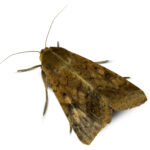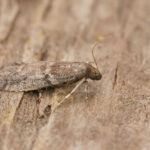How Can We Help?
What are some common moth species found in homes and buildings?
In the UK, several common moth species often show up in homes and buildings, causing damage to fabrics and stored food. The webbing clothes moth (Tineola bisselliella) is one of the most common, easily recognizable by its small, golden look. Its larvae are infamous for munching on natural fibers like wool, fur, and feathers, leaving behind silky webs and irregular holes in clothing and upholstery. Another common one is the case-bearing clothes moth (Tinea pellionella), which has a similar diet but stands out with dark spots on its wings and the portable silk cases its larvae create and carry around.
silky webs and irregular holes in clothing and upholstery. Another common one is the case-bearing clothes moth (Tinea pellionella), which has a similar diet but stands out with dark spots on its wings and the portable silk cases its larvae create and carry around.
The Indian meal moth (Plodia interpunctella) is another regular pest, especially in kitchens and pantries. This moth has reddish-brown and cream-colored wings and is mainly a problem because its larvae infest an array of dry food products like grains, cereals, nuts, and dried fruits, often leaving them contaminated with silk webbing and droppings.
The brown house moth (Hofmannophila pseudospretella) is also frequently seen in UK homes. These moths prefer damp, dark spots, and their larvae feed on various materials such as wool, feathers, and even dried plant matter.
Lastly, the white-shouldered house moth (Endrosis sarcitrella) is a common sight in homes. It's easy to identify with its white head and shoulders and dark wings. Its larvae feed on a variety of organic materials, including textiles and stored food products.
Where are moths most likely to be found living and breeding inside a home?
Moths are most likely to hang out and breed in dark, undisturbed areas of a home where they can find food. Clothes moths, like the webbing clothes moth and the case-bearing clothes moth, often invade wardrobes, closets, and drawers. They love these spots because they offer dark, quiet environments and a steady supply of natural fibers like wool, silk, and fur for their larvae. You might also find them in attics and basements, especially if you have stored clothing, blankets, or upholstery there.
Pantry moths, such as the Indian meal moth, prefer kitchens and pantries where dry food items are kept. They infest and contaminate them with their larvae, silk webbing, and droppings. These moths often hide in food storage containers, cupboards, and behind appliances where food crumbs might gather.
The brown house moth and the white-shouldered house moth can pop up in various places around the home, especially in damp, dark areas. They can infest storage spaces, basements, and garages where they have access to organic materials like wool, feathers, and stored food products.
How can you tell if you have an active moth infestation versus just a few occasional moths?
Figuring out if you have a moth infestation or just a few stray moths involves spotting signs of ongoing and widespread activity. An active infestation usually means finding multiple moths regularly, especially in places where food or clothing is stored. For clothes moths, look for larvae or silken webbing on clothes, closets, or drawers. Small holes in fabrics, irregularly chewed materials, and discarded larval casings are clear signs, too. If you see these signs in various spots, it's more likely to be an infestation rather than an isolated incident.
For pantry moths, an active infestation can be identified by moths flying around the kitchen or pantry, especially near dry food storage. Check food containers for larvae, silk webbing, and small holes in packaging. Infested food
Regularly finding droppings or frass (a powdery residue from larvae) around infested areas also suggests an active infestation. On the other hand, a few occasional moths might appear without these signs of breeding and feeding. To confirm an infestation, using pheromone traps can help as they attract and capture moths, allowing you to monitor their presence and assess the situation. If you notice consistent activity over several days or weeks, it's likely an active infestation. Taking prompt action, like thorough cleaning, proper storage, and using repellents, is crucial to manage and get rid of the infestation.
How can homeowners identify the entry points that allow moths to get into a building?
Homeowners can find where moths are sneaking into a house by doing a thorough check of potential entry points. Start by looking at windows and doors, making sure screens are intact and fit snugly. Check for gaps around window frames, doors, and thresholds, as these can be entryways for moths. Pay special attention to places where utility lines, pipes, or vents enter the house; these often have small gaps or cracks that can be sealed with caulk or weatherstripping.
Inspect attics, basements, and crawl spaces since these spots often have overlooked openings. Check for gaps in the roofing, especially around eaves and soffits, and make sure attic vents are properly screened. Examine the foundation for any cracks or holes, and ensure basement windows are well-sealed with intact screens.
In the kitchen and pantry, look for gaps around plumbing pipes under sinks and behind appliances. Moths can also come in through open windows, so it's important to use screens and keep windows closed when not in use. Also, make sure exterior lights, which attract moths, are positioned away from entry points, or use yellow or sodium vapor bulbs that are less attractive to insects.
Regularly checking these areas and fixing any identified gaps or openings can significantly reduce the chances of moths getting into your home. These simple steps, along with proper storage of food and clothing, help prevent moth infestations and keep your home moth-free. Here at Youngs Pest Control, we can also assist you with identifying potential entry points to keep moths out of your home. So, if you suspect a moth infestation, don't hesitate to contact us for professional help and advice.
